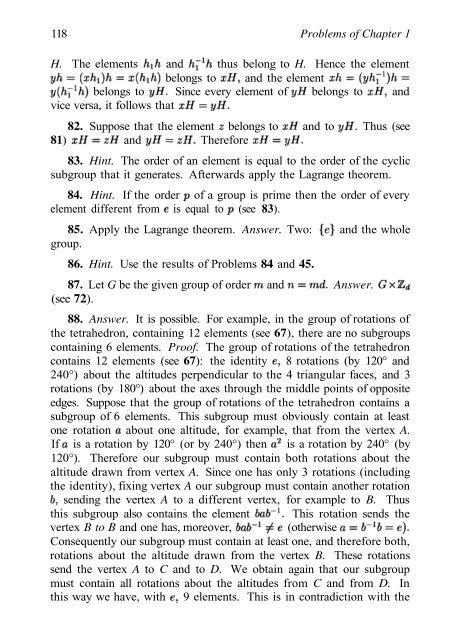Abel's theorem in problems and solutions - School of Mathematics
Abel's theorem in problems and solutions - School of Mathematics
Abel's theorem in problems and solutions - School of Mathematics
Create successful ePaper yourself
Turn your PDF publications into a flip-book with our unique Google optimized e-Paper software.
118 Problems <strong>of</strong> Chapter 1<br />
H. The elements <strong>and</strong> thus belong to H. Hence the element<br />
belongs to <strong>and</strong> the element<br />
belongs to S<strong>in</strong>ce every element <strong>of</strong> belongs to <strong>and</strong><br />
vice versa, it follows that<br />
82. Suppose that the element belongs to <strong>and</strong> to Thus (see<br />
81) <strong>and</strong> Therefore<br />
83. H<strong>in</strong>t. The order <strong>of</strong> an element is equal to the order <strong>of</strong> the cyclic<br />
subgroup that it generates. Afterwards apply the Lagrange <strong>theorem</strong>.<br />
84. H<strong>in</strong>t. If the order <strong>of</strong> a group is prime then the order <strong>of</strong> every<br />
element different from is equal to (see 83).<br />
85. Apply the Lagrange <strong>theorem</strong>. Answer. Two: <strong>and</strong> the whole<br />
group.<br />
86. H<strong>in</strong>t. Use the results <strong>of</strong> Problems 84 <strong>and</strong> 45.<br />
87. Let G be the given group <strong>of</strong> order <strong>and</strong> Answer.<br />
(see 72).<br />
88. Answer. It is possible. For example, <strong>in</strong> the group <strong>of</strong> rotations <strong>of</strong><br />
the tetrahedron, conta<strong>in</strong><strong>in</strong>g 12 elements (see 67), there are no subgroups<br />
conta<strong>in</strong><strong>in</strong>g 6 elements. Pro<strong>of</strong>. The group <strong>of</strong> rotations <strong>of</strong> the tetrahedron<br />
conta<strong>in</strong>s 12 elements (see 67): the identity 8 rotations (by 120° <strong>and</strong><br />
240°) about the altitudes perpendicular to the 4 triangular faces, <strong>and</strong> 3<br />
rotations (by 180°) about the axes through the middle po<strong>in</strong>ts <strong>of</strong> opposite<br />
edges. Suppose that the group <strong>of</strong> rotations <strong>of</strong> the tetrahedron conta<strong>in</strong>s a<br />
subgroup <strong>of</strong> 6 elements. This subgroup must obviously conta<strong>in</strong> at least<br />
one rotation about one altitude, for example, that from the vertex A.<br />
If is a rotation by 120° (or by 240°) then is a rotation by 240° (by<br />
120°). Therefore our subgroup must conta<strong>in</strong> both rotations about the<br />
altitude drawn from vertex A. S<strong>in</strong>ce one has only 3 rotations (<strong>in</strong>clud<strong>in</strong>g<br />
the identity), fix<strong>in</strong>g vertex A our subgroup must conta<strong>in</strong> another rotation<br />
send<strong>in</strong>g the vertex A to a different vertex, for example to B. Thus<br />
this subgroup also conta<strong>in</strong>s the element This rotation sends the<br />
vertex B to B <strong>and</strong> one has, moreover, (otherwise<br />
Consequently our subgroup must conta<strong>in</strong> at least one, <strong>and</strong> therefore both,<br />
rotations about the altitude drawn from the vertex B. These rotations<br />
send the vertex A to C <strong>and</strong> to D. We obta<strong>in</strong> aga<strong>in</strong> that our subgroup<br />
must conta<strong>in</strong> all rotations about the altitudes from C <strong>and</strong> from D. In<br />
this way we have, with 9 elements. This is <strong>in</strong> contradiction with the

















